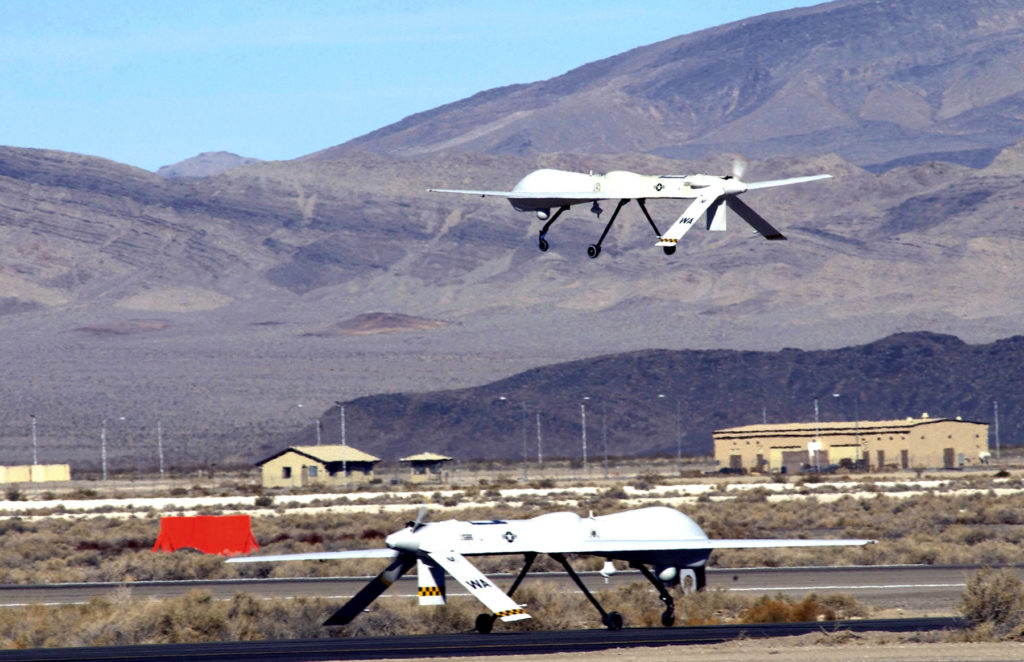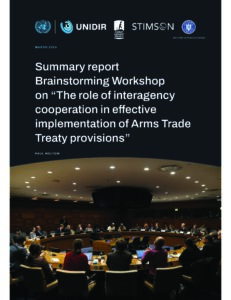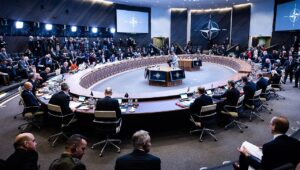Editor’s note: This analysis is part of 2020 Presidential Inbox — an ongoing Stimson Center series examining the major global challenges and opportunities the next administration faces.
Problem
U.S. drone policy prioritizes immediate military action, resulting in a U.S. approach that often appears less restrained, transparent, and accountable. As drones continue to proliferate and more countries look to acquire and use lethal drone capabilities, questions of efficacy, legality, transparency, and accountability will continue to raise concerns about the precedent being set by the current U.S. drone program. The United States has an opportunity to be a leader on this issue and ensure that U.S. policy on drones is responsible, transparent, and sets an appropriate benchmark for drone transfers and use around the world.
Background
A Tempting Tool of War
Perhaps no tool has characterized U.S. involvement in counterterrorism operations around the world more than armed drones. Their loitering and persistent capabilities, the presumption that they carry less risk than manned aircraft, and the strong convictions of their precision, have made drones attractive to military commanders and politicians alike. However, there are several challenges to the U.S. drone program approach that persisted through previous administrations and are being exacerbated in the Trump administration.
More than 17 years after the first U.S. drone strike, the drone program remains shrouded in secrecy, complicating effective oversight and making independent assessments of the legitimacy and efficacy of the U.S. drone program extraordinarily challenging.
Reduced Transparency and Accountability
The Trump administration has demonstrated a continued commitment to the use of military force, including via armed drones, in efforts to advance U.S. military and national security objectives. Yet with this continued — and at times escalated — use of lethal drone strikes, the Trump administration appears to be reducing the transparency of and accountability for the U.S. drone program.
During its first 18 months in office, the Trump administration rolled back certain policies and practices that guided U.S. drone use and increased both the frequency and geographic scope of strikes. These changes include:
- Granting military operators greater strike-decision authority and expanding the CIA’s role and responsibilities in lethal strike operations.
- Removing the requirement, established under Executive Order 13732, to report on casualties resulting from strikes undertaken by the United States outside combat zones.
- Allowing drones to be sold via the State Department’s Direct Commercial Sales (DCS) program, meaning industry can negotiate contracts with recipients without the involvement of the U.S. government.
- Removing special scrutiny for laser designators, meaning strike-enabled drones can be made available more widely and more easily.
- Reducing oversight on the use of U.S.-sold drones. The administration determined that drone exports will be subject to possible enhanced end-use monitoring, instead of obligatory enhanced end-use monitoring (EUM). This means that drone exports will be treated the same as most other defense articles and will no longer require special export conditions or end-use checks.
Each of these changes occurred under a veil of secrecy, as the administration has not publicly released the policies, principles and procedures guiding the U.S. drone program. Such secrecy further challenges the legitimate and responsible use of armed drones that supports broader U.S. objectives and undermines accountability for U.S. actions. Without a more transparent and accountable U.S. drone policy, the United States risks undermining national security interests, foreign policy objectives, and commercial opportunities.
U.S. Precedent Matters When Other States Have Armed Drones
The current approach to U.S. drone policy holds considerable risks, particularly as drones proliferate around the world. The reality is that the United States does not maintain a monopoly on the use of armed drones, nor do national governments alone retain a monopoly on the use of this technology. In developing its own practice for conducting lethal drone operations, the United States is setting a de facto international standard for minimal transparency and accountability regarding drone use, even though such a standard may run counter to global norms for use. In short, U.S. policy and practice impacts not only what is happening within and to the United States, but how our allies, partners, and even our adversaries utilize drones for their own purposes.
Opportunity for Global Leadership to Protect U.S. National Leadership
The United States has an opportunity to exert global leadership and establish an appropriate and responsible policy on armed drones. Through executive action and working with Congress, the president could improve U.S. drone policy and ensure that it values human rights, the rule of law, and good governance that would protect U.S. national security interests and help set a responsible international precedent, furthering U.S. foreign policy ideals and principles.
Recommendations for the President
- Policy transparency. Publicly release and explain any new policies, principles, standards, or procedures guiding the U.S. drone program. At a minimum, the insufficient transparency that was established at the end of the Obama administration should be reinstated, but far more is needed to provide an accurate and comprehensive picture of the U.S. policy, law, and regulatory framework for U.S. drone use.
- Drone use transparency. Publicly release the number and location of all drone strikes on an annual basis, as well as the number and location of combatants and noncombatants killed in such strikes. This includes reports required under the 2018, 2019, and 2020 NDAAs on the legal and policy frameworks governing the U.S. use of military force and related national security operations and on civilian casualties caused by U.S. military operations, as well as the report required under Section 1723 of the 2020 NDAA on the number of strikes undertaken outside areas of active hostilities and estimated civilian and “combatant” casualties.
- Consider long-term impact. Undertake a strategic assessment of the efficacy and long-term impact of the U.S. drone program. The U.S. government should undertake a serious cost-benefit analysis of targeted UAV strikes that examines the balance between kinetic action and other counterterrorism tools, and the potential unintended consequences of use and reliance of armed drones.
- Increase oversight of U.S. drone exports. Uphold international human rights law and international humanitarian law through the continuation of written assurances on use from U.S. drone export recipients. Such assurances should include post-transfer monitoring and initiate corrective action if violations are found. Assurances should be provided pre-transfer, and a recipient’s human rights record and record of compliance with international humanitarian law, as well as the will and capacity to comply with international law after the sale, should be assessed as part of the transfer process.




